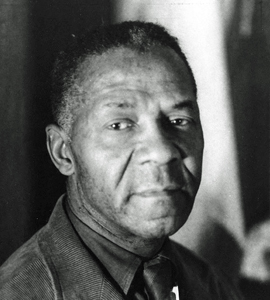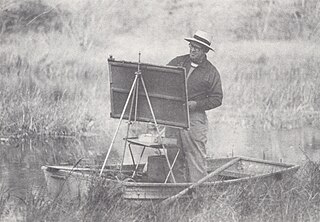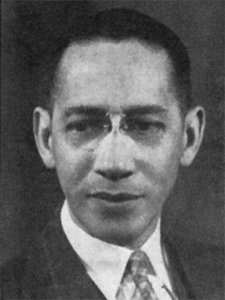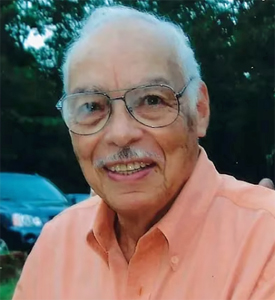Related Research Articles

Dox Thrash (1893–1965) was an African-American artist who was famed as a skilled draftsman, master printmaker, and painter and as the co-inventor of the Carborundum printmaking process. The subject of his artwork was African American life. He served as a printmaker with the W.P.A. at the Fine Print Workshop of Philadelphia. The artist spent much of his career living and working in Philadelphia, Pennsylvania.

Claude Clark was an American painter, printmaker and art educator. Clark's subject matter was the diaspora of African American culture, including dance scenes, street urchins, marine life, landscapes, and religious and political satire images executed primarily with a palette knife.

Allan Randall Freelon Sr., a native of Philadelphia, US, was an African American artist, educator and civil rights activist. He is best known as an African American Impressionist-style painter during the time of the Harlem Renaissance and as the first African American to be appointed art supervisor of the Philadelphia School District.

Ellen Powell Tiberino (1937-1992) was an African American artist who was figurative and expressionist in her pastels, oils, pencil drawings and sculptures. Her works were infused with the experiences and history of Black people, women in particular, whom she most often painted in dark and haunting hues. She was a prolific artist, working against time as she battled cancer for the last 14 years of her life.
Raymond Steth, born Raymond Ryles, was a Philadelphia-based graphic artist recognized for his paintings and lithographs on the African-American condition in the mid-20th century, often through scenes of rural life and poverty. Working under the Works Progress Administration's graphics division in the 1930s and 1940s, Steth's art covered a range of topics and emotions from pleasurable farm life to protest and despair.
John Edward Dowell Jr. is an American printmaker, etcher, lithographer, painter, and professor of printmaking at the Tyler School of Art at Temple University.

John W. Mosley was a self-taught photojournalist who extensively documented the everyday activities of the African-American community in Philadelphia, Pennsylvania, for more than 30 years, a period including both World War II and the civil rights movement. His work was published widely in newspapers and magazines including The Philadelphia Tribune, The Pittsburgh Courier and Jet magazine.
Elizabeth Kitchenman Coyne was a Pennsylvania impressionist painter, best known for her landscapes and paintings of horses. Her works are included in the permanent collections of the Pennsylvania Academy of the Fine Arts, the Woodmere Art Museum and the Philadelphia Art Alliance.
Louise D. Clement-Hoff was an American painter and educator who specialized in oil painting, pastel and drawing of human figures and still lifes.

Roswell Weidner was an American artist known for his paintings, charcoal and pastel drawings, and prints. His subject matter included still life, landscapes, and portraits. He was a student at the Pennsylvania Academy of the Fine Arts (PAFA) city school and country school in Chester Springs, and the Barnes Foundation. He worked in the Works Progress Administration Arts Project during the Great Depression and in a shipyard as an expediter during World War II. Weidner began teaching at the Pennsylvania Academy of the Fine Arts in 1938. He was associated with the academy for 66 years, first as a student and later as a teacher, until his retirement in 1996.

Samuel Joseph Brown Jr. (1907–1994) was a watercolorist, printmaker, and educator. He was the first African American artist hired to produce work for the Public Works of Art Project, a precursor to the Work Progress Administration's Federal Art Project. Brown often depicted the lives of African Americans in his paintings. He worked primarily in watercolor and oils, and he produced portraits, landscapes and prints.

Dr. Oscar James Cooper (1888–1972) was a physician and African-American cultural leader. He is known for cofounding Omega Psi Phi in Washington, D.C., the first fraternity founded by students at a historically black college. In Philadelphia, Pennsylvania, he was a charter member of the Pyramid Club.

Louis B. Sloan (1932–2008) was an African American landscape artist, teacher and conservator. He was the first Black full professor at the Pennsylvania Academy of the Fine Arts (PAFA), and a conservator for the academy and the Philadelphia Museum of Art. Although he painted urban neighborhoods and other cityscapes, he was mostly known for his plein-air paintings.

Columbus P. Knox (1923–1999) was a painter, muralist, illustrator and printmaker. He was a mainstay at the annual Rittenhouse Square Fine Arts Show in Philadelphia, the oldest outdoor art exhibition in the country. His works are in museums and private collections. Knox created his own style of painting: using brushstrokes that resembled a rake being pulled through sand.

Benjamin Franklin (Ben) Britt (1923–1996) was a figurative, surrealist and abstract painter, and art teacher. His subjects were African American culture, religion and children, which he captured in oil and charcoals. Britt signed his works “B. Britt,” dotting the “i” with tiny round circles.
Henry Bozeman Jones was an African American artist, writer, print-maker, illustrator, teacher, athletic coach and school counselor. He was known primarily for his portraits and landscapes.
Reba Dickerson-Hill was a self-taught Philadelphia artist who painted in the ancient Japanese ink-and- brush technique called sumi-e. She was also a watercolorist and oil painter who primarily produced landscapes and portraits.

Humbert Howard was an American artist and art director of the Pyramid Club.

Howard N. Watson (1929–2022) was an African American watercolorist, landscape artist, illustrator and teacher. He was known for his impressionistic watercolors of historical buildings, streets, neighborhoods and landmarks in the Philadelphia region.
We Speak: Black Artists in Philadelphia, 1920s–1970s was an art exhibition held at the Woodmere Art Museum from September 26, 2015 through January 24, 2016. It included artists from Philadelphia who were active from the 1920s through the 1970s. Many of those artist were invlolved with the Pyramid Club and other local organizations. The exhibit included paintings, photographs, prints, drawings and sculpture from the New Negro movement of the 1920s, the Works Progress Administration print works of the 1930s and the Civil rights era.
References
- 1 2 "Pyramid Club's black arts legacy". Auction Finds. Retrieved 22 February 2018.
- 1 2 3 4 Brigham, David R. "The Pyramid Club and the Pennsylvania Academy of Fine Arts". Antiques & Fine Art. Retrieved 22 February 2018.
- ↑ "Pyramid Club Purchases Site for Clubhouse". Philadelphia Tribune. February 29, 1940. p. 2.
- ↑ Booker, Bobbi (11 February 2003). "Pyramid Club was a sign of elite status". Philadelphia Tribune. Philadelphia, PA.
- 1 2 3 Crimmins, Peter (September 29, 2015). "Woodmere exhibit follows Philly's black artists through a tumultuous half-century". WHYY. Retrieved 13 March 2018.
- 1 2 3 Anderson, Faye (8 March 2015). "Philadelphia Pyramid Club". All That Philly Jazz. Retrieved March 8, 2015.
- 1 2 "Dox Thrash House" (PDF). NOMINATION OF HISTORIC BUILDING, STRUCTURE, SITE, OR OBJECT PHILADELPHIA REGISTER OF HISTORIC PLACES PHILADELPHIA HISTORICAL COMMISSION. Retrieved 13 March 2018.
- ↑ "Philadelphia Pyramid Club". Pennsylvania Historical & Museum Commission. Retrieved 14 March 2018.
- ↑ "Except from "Pictorial Album of The Pyramid Club, First Anniversary, October, 1941, Philadelphia, PA"". Howard Heartsfield Studio/Gallery. Retrieved 14 March 2018.
- 1 2 "Pyramid Club Members NAACP". The Crisis. No. May. 1944. p. 157. Retrieved 10 March 2018.
- ↑ "Pyramid Club, Philadelphia". Woodmere Art Museum. Retrieved 22 February 2018.
- 1 2 3 4 "Pyramid Club's forgotten women artists". Auction Finds. Retrieved 13 March 2018.
- ↑ "Oral history interview with Humbert Howard, 1988 Oct. 26". Smithsonian Archives of American Art. Retrieved 13 March 2018.
- ↑ Howard, Humbert; King-Hammond, Leslie; Panzera, Lisa; Collier-Thomas, Bettye (1996). Humbert Howard, Philadelphia painter: exhibition, January 17 – February 29, 1996. Philadelphia, PA: Levy Gallery for the Arts in Philadelphia.
- ↑ "Beauford in Philadelphia: The 1947 Pyramid Club Show". Les Amis de Beauford Delaney. August 22, 2015.
- ↑ Wintz, Cary D.; Finkelman, Paul, eds. (2004). Encyclopedia of the Harlem Renaissance. Vol. 1, A–J. New York: Routledge. p. 517. ISBN 9781579584573 . Retrieved 23 February 2018.
- ↑ Brigham, David (2001). "Dox Thrash and the Pyramid Club". In Ittmann, John (ed.). Dox Thrash: An African American Master Printmaker Rediscovered. Philadelphia: Philadelphia Museum of Art. pp. 53–65.
- ↑ "Selma Burke's sculpture Island Dancers at a Pyramid Club exhibition curated by Dox Thrash, Philadelphia". Woodmere Art Museum. Retrieved 13 March 2018.
- ↑ Bingaman, Brian (January 1, 2016). "Fifty years of art by Philadelphia African-Americans showcased in Woodmere exhibit". Berks-Mont Entertainment. Retrieved 13 March 2018.
- ↑ Kirsh, Andrea (December 28, 2015). "We Speak: Black Artists in Philadelphia, 1920s–1970s at the Woodmere Art Museum". ArtBlog.
- ↑ Valerio, William R. (2015). We speak : black artists in Philadelphia, 1920s–1970s. Philadelphia, PA: Woodmere Art Museum.
- ↑ Blockson, Charles L. (1992). The journey of John W. Mosley. Philadelphia: Quantum Leap Publisher. ISBN 978-0962716171.
- 1 2 Jelesiewicz, Eryn (June 13, 2012). "Blockson Collection Photos give inside view of African-American life from 1930s to 1960s". Temple Now. Retrieved 2 March 2018.
- ↑ Wellington, Elizabeth (October 24, 2016). "A Million Faces: This John W. Mosley exhibit will leave Philadelphians reminiscing". The Inquirer. Retrieved 2 March 2018.
- ↑ "Black Philadelphia, 1930's-1960's: John W. Mosley's photographs of 'A Million Faces'". Vin de Vie Wine of Life. October 1, 2016. Retrieved 2 March 2018.
- ↑ Bixler, Michael (September 30, 2016). "A Million Faces Celebrates The Photography Of John Mosley". Hidden City Philadelphia. Retrieved 2 March 2018.
- ↑ "Black Philadelphia through the lens of John W. Mosley". Auction Finds. 26 September 2016. Retrieved 5 March 2018.
- ↑ "John W. Mosley Photographs". Temple University Libraries. Retrieved 2 March 2018.
- ↑ Hine, Thomas (December 4, 2016). "John Mosley's photos at Woodmere: The Philly African American world at midcentury". The Inquirer. Retrieved 2 March 2018.